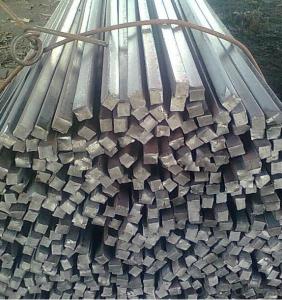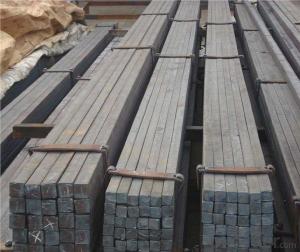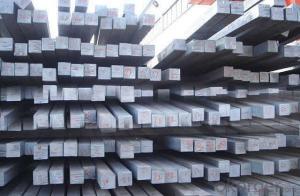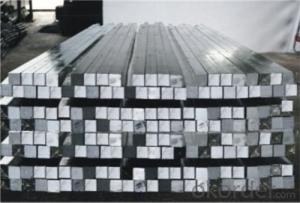Square Bar, Hot Rolled with High Qaulity
- Loading Port:
- China main port
- Payment Terms:
- TT or LC
- Min Order Qty:
- 25 m.t.
- Supply Capability:
- 10000 m.t./month
OKorder Service Pledge
OKorder Financial Service
You Might Also Like
Product Description of Square Bar, Hot Rolled with High Qaulity :
-Standard: GB,
-Grade: Q195 or equivalent.
-Chemical Composition:
Standard | Grade | Element (%) | ||||
GB | Q195 | C | Mn | S | P | Si |
0.06~0.12 | 0.25~0.50 | ≤0.050 | ≤0.045 | ≤0.30 | ||
Measures of Square Bar, Hot Rolled with High Qaulity:
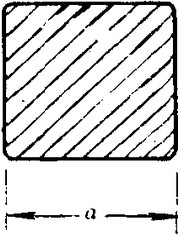 :
:
(Section of HR Square Bar)
-Length of a side and Theoretical weight of Square Bar.
Length of a side(mm) | Theoretical weight(kg/m) | Length of a side(mm) | Theoretical weight(kg/m) |
7 | 0.385 | 22 | 3.80 |
8 | 0.502 | 24 | 4.52 |
9 | 0.636 | 25 | 4.91 |
10 | 0.785 | 26 | 5.30 |
11 | 0.950 | 28 | 6.15 |
12 | 1.13 | 30 | 7.06 |
13 | 1.33 | 32 | 8.04 |
14 | 1.54 | 34 | 9.07 |
15 | 1.77 | 36 | 10.17 |
16 | 2.01 | 38 | 11.24 |
17 | 2.27 | 40 | 12.56 |
18 | 2.54 | 42 | 13.85 |
19 | 2.82 | 45 | 15.90 |
20 | 3.14 | 48 | 18.09 |
21 | 3.46 | 50 | 19.63 |
Notes:
1, The theoretical weights in the list, base on the density of 7.85 g/cm3.
2, Formula for theoretical weight of Square bar: (length of a side)2 * 0.00785
3, The numbers with *mean that they are not regular or we don’t offer them.
-Regular length of Square Bar:
Steel | Length of a side (mm) | Length of steel (m) |
Normal steel | < 25 | 4~10 |
> 25 | 3~9 | |
Steel of high quality | All measure | 2~6 |
Tool steel >75 | 1~6 |
Usage/Applications of Square Bar, Hot Rolled with High Qaulity:
-The Square Bar is normally used as structure steel.
-Row material for other structure steel like steel angles, channels, I-beams, H-beams, etc…
Packaging & Delivery of Square Bar, Hot Rolled with High Qaulity:
-Packing Detail: The products can be packed in bundles by steel wires.
-Marks: We make tag marks and color marks. The tag marks with white background and red company logo will be tied up to each bundle of the products. The information is usually including basic information of products and company and other information requested by customers. As for color marks, we will paint both ends of bundles to make sure that it will be more convenient for customers to distinguish them from other products.
-Delivery Detail: 30~45 working days after receive buyer’s T.T. or L/C.
FAQ:
Q1: Why buy Materials & Equipment from OKorder.com?
A1: All products offered byOKorder.com are carefully selected from China's most reliable manufacturing enterprises. Through its ISO certifications, OKorder.com adheres to the highest standards and a commitment to supply chain safety and customer satisfaction.
Q2: How do we guarantee the quality of our products?
A2: We have established an advanced quality management system which conducts strict quality tests at every step, from raw materials to the final product. At the same time, we provide extensive follow-up service assurances as required.
Q3: How soon can we receive the product after purchase?
A3: Within three days of placing an order, we will begin production. The specific shipping date is dependent upon international and government factors, but is typically 7 to 10 workdays.
Images:
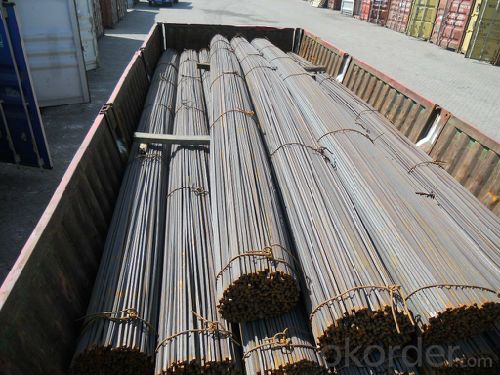
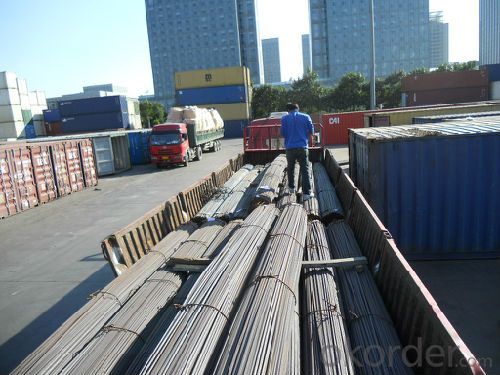
- Q:How do you use a steel square to find the square footage of a deck?
- To determine the square footage of a deck using a steel square, there are several straightforward steps you should follow. Firstly, ascertain that you possess a steel square, also referred to as a framing square. This tool has a triangular shape with a lengthy arm and a shorter arm forming a 90-degree angle. To commence, measure the width by positioning the shorter arm of the steel square against the deck's side and aligning it with the edge. Extend the longer arm across the deck's width, ensuring that the steel square is accurately placed with the shorter arm perpendicular to the deck's edge. Next, mark the measurements by tracing along the longer arm of the steel square where it aligns with the deck's edge. This will create a straight line across the deck's width. Subsequently, measure the length by relocating the steel square to the opposite side of the deck. Align the shorter arm with the side edge once again and extend the longer arm along the deck's length, ensuring it remains perpendicular to the side edge. Repeat the marking process by tracing along the longer arm of the steel square where it aligns with the deck's length. This will create a straight line across the deck's length. With the width and length of the deck marked using the steel square, you can now calculate the square footage. Measure the distance between the two width lines you marked and record the measurement. Similarly, measure the distance between the two length lines and note the measurement. Multiply these two measurements together to obtain the square footage of the deck. In the event that your deck incorporates irregular shapes or sections, repeat the aforementioned steps for each area. Subsequently, add the square footage of each section together to obtain the total square footage of the deck. Using a steel square to determine the square footage of a deck is a straightforward and reliable method that ensures accuracy in your calculations.
- Q:How do you use a steel square to measure and mark 22.5-degree angles?
- To measure and mark a 22.5-degree angle using a steel square, first, align one side of the square with the edge of the material you're working on. Then, pivot the square until the 45-degree angle line aligns with the edge. Next, find the midpoint between the 45-degree angle line and the right angle corner of the square. Finally, draw a line from this midpoint to the edge of the material, creating a 22.5-degree angle.
- Q:How do you use a steel square to determine the angle of a profile cut?
- In order to determine the angle of a profile cut, you must follow a few steps using a steel square. Firstly, make sure that your steel square is clean and free from debris or rust. Then, place the steel square flush against the side of the material you want to cut at a right angle, ensuring a snug fit against the surface. Once the steel square is properly positioned, examine the markings on it. Most steel squares have markings indicating angles, typically ranging from 0 to 90 degrees. These markings can be found on both the blade and the tongue of the square. To determine the angle of the profile cut, locate the marking on the blade that aligns with the edge of the material. This marking will indicate the angle at which the cut should be made. If the marking on the blade is not an exact match, you can estimate the angle by looking at the closest marking and measuring the difference. After determining the angle, you can transfer it to your cutting tool or machine to make an accurate profile cut. It is important to note that the accuracy of the angle measurement depends on the precision and calibration of your steel square, so ensure that it is in good condition before using it for such measurements. Using a steel square to determine the angle of a profile cut is a straightforward and efficient method, particularly when dealing with materials that require precise and accurate cuts.
- Q:Can a steel square be used for checking the plumbness of a post?
- No, a steel square cannot be used for checking the plumbness of a post. A steel square is primarily used for measuring and marking right angles in woodworking and carpentry. To check the plumbness of a post, a level or plumb bob should be used. A level is a tool with a vial of liquid that shows if a surface is perfectly vertical or horizontal. A plumb bob is a weighted object attached to a string, which is hung from the top of the post to determine if it is perfectly plumb. Both of these tools are more accurate and reliable for checking the plumbness of a post compared to a steel square.
- Q:Can a steel square be used for precise woodworking?
- Yes, a steel square can be used for precise woodworking. Steel squares are commonly used in woodworking for accurate measurements, marking, and checking right angles. They are durable, provide straight edges, and are suitable for various woodworking tasks such as marking lines, checking corners, and ensuring accurate cuts and joints.
- Q:Can a steel square be used for fabricating metal parts?
- A steel square is capable of being utilized in the fabrication of metal parts. This particular tool, also referred to as a framing square or a carpenter's square, is highly adaptable and commonly employed in both woodworking and metalworking. Its robust steel construction renders it suitable for the purpose of marking and measuring angles, establishing precise lines and shapes, and verifying the squareness of corners. In the realm of metal fabrication, a steel square can be employed to guarantee meticulous cuts, angles, and dimensions. Especially in tasks such as welding, cutting, and bending metal parts, it serves as a trustworthy point of reference for achieving accurate and symmetrical outcomes. Consequently, a steel square holds significant value as a tool that greatly aids in the fabrication of metal parts.
- Q:Can a steel square be used for deck building?
- Yes, a steel square can definitely be used for deck building. Steel squares, also known as framing squares or carpenter squares, are versatile tools that are commonly used in construction projects, including deck building. They are typically made of steel and have a 90-degree angle, allowing for accurate measurements and angles to be marked and cut. Steel squares are particularly useful for laying out and measuring the framing of a deck, ensuring that the corners are square and the joists are properly aligned, resulting in a structurally sound and level deck. Additionally, steel squares are durable and can withstand the rigors of outdoor construction, making them a reliable tool for deck building.
- Q:How do you use a steel square to measure the height of a wall opening?
- Before measuring the height of a wall opening using a steel square, it is essential to verify that the steel square is perfectly squared, meaning that its edges form right angles. Once you have confirmed that the steel square is squared, proceed with the following steps: 1. Place the steel square against the wall, ensuring that the longer side is positioned vertically against the wall and the shorter side is placed horizontally at the bottom of the opening. 2. Adjust the position of the steel square by sliding it up or down until the shorter side aligns with the bottom of the wall opening. 3. Maintain a firm grip on the steel square to keep it securely against the wall. 4. Examine the graduations or markings on the vertical side of the steel square. These markings indicate the units of measurement, such as inches or centimeters. 5. Identify the graduation that corresponds with the top edge of the wall opening. This indicates the height of the opening. 6. Take note of the measurement displayed on the steel square, representing the height of the wall opening. It is crucial to remember to keep the steel square level and hold it firmly to prevent any movement that could affect the accuracy of the measurement. Additionally, ensure that you read the measurements correctly and double-check your calculations to guarantee precise results.
- Q:How does a steel square assist in laying out stairs?
- When it comes to laying out stairs, carpenters and builders rely heavily on the versatility of a steel square. This essential tool is specifically designed to provide accurate measurements and angles, making it invaluable in the construction process. Here are a few ways in which a steel square can assist in laying out stairs: 1. Rise and run determination: By utilizing the tongue and body of the steel square, builders can easily establish the rise and run of each step. Aligning the square with the stringer, the inclined board that supports the steps, allows for precise marking of the height (rise) and depth (run) of each step. 2. Angle setting: Safety and comfort are paramount when constructing stairs, and the steel square's adjustable angle feature proves invaluable in achieving the desired slope. By adjusting the square to the required angle, builders can effortlessly mark and cut the stringers accordingly. 3. Squareness checking: Ensuring that the corners and angles of the stairs are precisely 90 degrees, or square, is crucial for stability and safety. The steel square can be utilized to check the squareness of the stringers and verify proper alignment. This step is essential in avoiding any potential issues with the staircase's stability and safety. 4. Measurement transferring: Another beneficial function of the steel square is its ability to transfer measurements accurately. For instance, when determining the width of the stairs, the square can be used to mark the measurement from the stringer onto the tread, the horizontal part of the step. This ensures consistency and accuracy throughout the layout process. In summary, a steel square is an indispensable tool for laying out stairs. Its ability to measure, mark angles, check squareness, and transfer measurements accurately is highly beneficial for carpenters and builders. By utilizing a steel square, professionals can construct stairs with precision and in compliance with safety standards.
- Q:What are some common uses for a steel square in woodworking joinery?
- A steel square, also known as a framing square or carpenter's square, is a versatile tool used in woodworking joinery for a variety of purposes. Some common uses for a steel square include: 1. Measuring and marking right angles: The most basic use of a steel square is to ensure that corners and joints are perfectly square. Woodworking projects often require precise angles, and a steel square helps achieve accurate measurements and markings. 2. Checking for squareness: Before joining two pieces of wood together, it is crucial to check if they are square. A steel square is used to verify if the edges are at a perfect 90-degree angle, ensuring a tight and secure joint. 3. Laying out perpendicular lines: When marking cuts or making layouts, a steel square is invaluable in creating perpendicular lines. It helps ensure that cuts and joints are made at precise right angles, resulting in accurate and well-fitting pieces. 4. Determining and transferring angles: Steel squares often have additional markings that allow woodworkers to measure and transfer different angles. This feature makes them useful for creating miters, bevels, and other angled cuts or joints. 5. Checking for flatness: A steel square can also be used to determine if a surface is flat or level. By placing the square against the surface, woodworkers can identify any unevenness or deviations, allowing them to make necessary adjustments. 6. Acting as a saw guide: A steel square can be clamped or held firmly against the edge of a board, serving as a guide for a saw. This helps in making straight and accurate cuts, especially when working with handheld tools like circular saws or jigsaws. 7. Assisting in layout and design: Steel squares often have various measurements and markings etched onto them, making them helpful tools for layout and design work. Woodworkers can use the square to create proportional designs, take precise measurements, and establish consistent spacing. Overall, a steel square is an essential tool in woodworking joinery, enabling woodworkers to achieve accuracy, ensure squareness, and create well-fitting joints. Its versatility and reliability make it a staple in any woodshop, aiding in a wide range of tasks and contributing to the overall quality of woodworking projects.
1. Manufacturer Overview |
|
|---|---|
| Location | |
| Year Established | |
| Annual Output Value | |
| Main Markets | |
| Company Certifications | |
2. Manufacturer Certificates |
|
|---|---|
| a) Certification Name | |
| Range | |
| Reference | |
| Validity Period | |
3. Manufacturer Capability |
|
|---|---|
| a)Trade Capacity | |
| Nearest Port | |
| Export Percentage | |
| No.of Employees in Trade Department | |
| Language Spoken: | |
| b)Factory Information | |
| Factory Size: | |
| No. of Production Lines | |
| Contract Manufacturing | |
| Product Price Range | |
Send your message to us
Square Bar, Hot Rolled with High Qaulity
- Loading Port:
- China main port
- Payment Terms:
- TT or LC
- Min Order Qty:
- 25 m.t.
- Supply Capability:
- 10000 m.t./month
OKorder Service Pledge
OKorder Financial Service
Similar products
New products
Hot products
Related keywords
